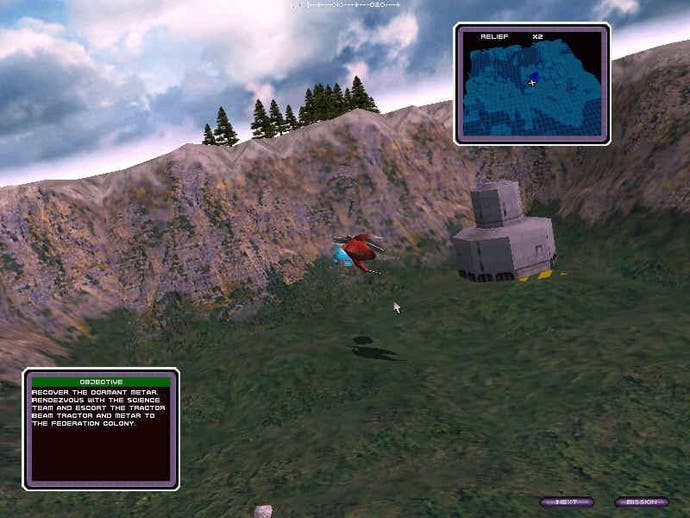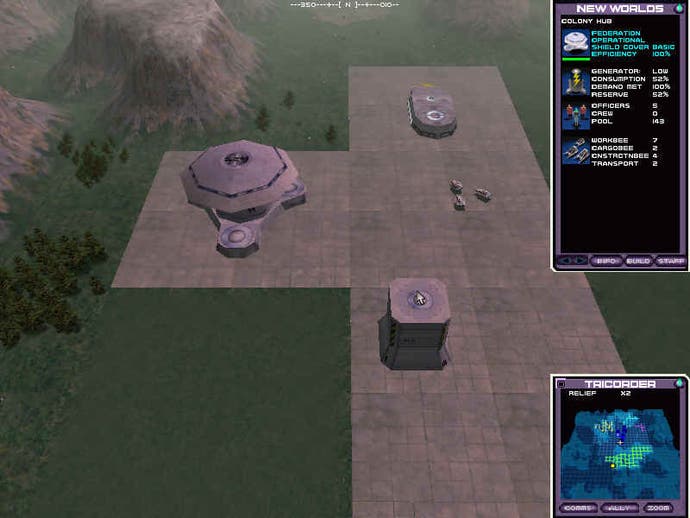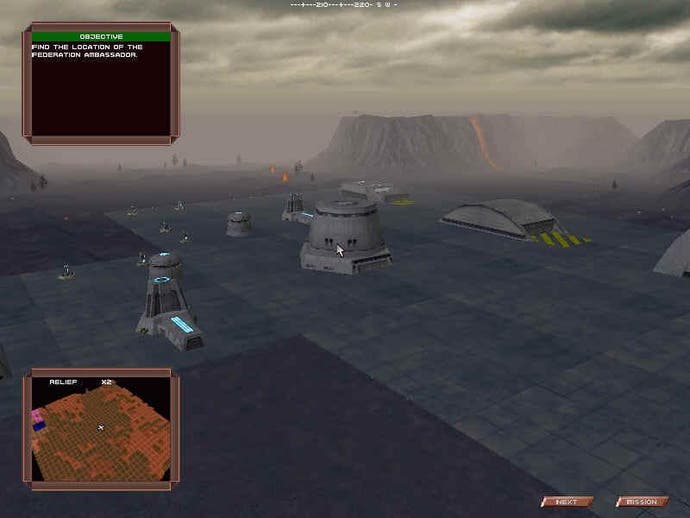Star Trek : New Worlds
Review - Interplay boldly take the Star Trek franchise where no game has gone before, with a ground-based strategy game
- 14 Degrees East / Binary Asylum UK Publisher - Virgin InteractiveUS Publisher - InterplaySystem Requirements - Pentium 266 or equivalent 32Mb RAM 195Mb hard drive space 3D graphics card

The Space-Time Continuum
Way back in the last millennium our very own Gestalt ventured into the dank, dark depths of Virgin's stand at ECTS 1999, and to his delight was shown a Star Trek game with some serious potential - a 3D real time strategy game set just before the events of "Star Trek VI", and coded by British developers Binary Asylum. It almost sounded too good to be true... Well, for Binary Asylum it was, as they ceased trading due to financial difficulties after being taken off the project by American publisher Interplay due to "creative differences". Not to be discouraged, Interplay handed the game to in-house team 14 Degrees East, who could be considered Star Trek experts after their work on the Starfleet and Klingon Academy games. Flash forward to September 2000, and after the drama and delays of its interrupted development cycle, the game has finally been released. The game starts when a Romulan experiment goes drastically wrong due to the interference of those meddlesome Klingons, resulting in a whole system of new planets getting dragged through some kind of temporal rift. Suddenly there are several new mineral-rich planets floating around in an area that used to be nothing but empty space. Cue escalating battles between the Klingons ("Ah .. new planets - let's kill everyone and take them for ourselves!"), the Romulans ("It was our experiment that brought them here, they are obviously ours!") and the Federation ("Ah .. strange new worlds - let's integrate the locals into our dreary existence"), as well as the added complication of three new races introduced in the game ("Ah .. erm .. we live here!"). The idea sounds fine in theory, and the game should have appealed to both Star Trek fans and real-time strategy players alike. But does the execution of the idea live up to expectations?

I'm A Happy Trekkie
The first thing you will notice on starting the game is that it looks wonderful - the HUD changes according to race, the terrain feels authentic, and the skies are a mash of glorious hues. Even the buildings look how you would expect a Star Trek building to look. And all of this is in lustrous 3D, with a flexible camera system which can do almost anything you would want it to - zooming and tilting, with everything from a bird's eye view to first person and chase cams. Sadly though you will spend almost all of your time in the overhead view, zoomed out as far as possible to get a wider view of the action. Once in a while, you may think "Oh, let's look at a different view", but then it's a case of "Oh dear, I can't see what's happening .. are those my units? No, don't go over there! Oh hell, are those explosions? Where's everyone gone?". Unlike Battlezone II, which balanced the different viewpoints successfully, you get the sense that the various camera options in New Worlds were just put there to show off the 3D engine. The missions are suitably complex though, from out and out fighting to search and rescue, and from scanning ancient crashed ships to finding a cure for a deadly virus, with all of the appropriate vehicles to go with it. You even have officers who you can place within ships to make their scanners, shields or weapons more efficient, and training these officers in their respective fields makes them more effective, adding an RPG element to the game. When you do get into battle the explosions are fantastic, and photon torpedoes veritably glower as they fly through the sky. Vessels with cloaking capabilities waver as they disappear, and all the while typically Trekkish sounds gush forth from your speakers. It all looks, sounds and feels like a Trek game should.

It's An RTS Jim, But Not As We Know It!
So, that pretty much covers the Trekkies - good looks, great story and interesting missions will have them grinning inanely and telling each other to 'live long and prosper', or some such. Real-time strategy fans, on the other hand, will have a harder time of it... With the recent influx of innovative and original strategy games - such as Shogun, Ground Control and Homeworld - the RTS fan really expects something special if their attention is to be held for any length of time, and unfortunately I found New Worlds to be lacking in many of the basics. For example, there is no research tree. Yes, you can only construct certain buildings when others are already present, and certain vehicles cannot be created until the science block has researched a disruptor field or some such, but this isn't strictly a research tree. Instead what tends to happen is that at the beginning of each mission you spend the first ten minutes upgrading and researching all of the same things that you already did in the previous mission, until there is nothing left to do. The problem is that you have to research lots of different technologies even to create the most basic of vehicles, so in the end it becomes less of a research tree and more of a monotonous bush. Resource collecting is a hassle too - other than a scanner mode which tells you where certain minerals are residing, there is nothing to indicate where to build a mine. You can spend many minutes with the template of a mine, sweeping across the terrain waiting for it to turn green, indicating that this is a good spot to build one. And while I'm at it, how come Kirk can find a lone person hidden in a cave on a huge world, but I can't scan the planet for the enemy, or even build some kind of radar? Instead you have to rely on short range scanner vehicles. To find the enemy you usually have to wait for them to come to you, and then head off in the direction they came from.

You Cannae Change The Laws Of Physics
More problems could be caused by the interface. Building is something of a chore, clicking backwards and forwards between screens, and having to click on each building to see if it can be upgraded yet. Getting your vehicles to actually do what they are told to is a mission of its own too. If you single click with your mouse the units will travel to that point, but it's anybody's guess what they will do when they get there. You can double-click an area, which brings up a mini-menu of icons, allowing you to order them to fire at will, protect the area, or even not to fire, but they rarely seem to take any notice of this, and just merrily blast away at anything they happen to see. But then sometimes they let enemy ships wander past and attack the building next to them without even batting an eyelid! It's also extremely difficult to double-click an enemy vehice when it is moving, which can get extremely frustrating. Most missions seem to degenerate into creating a ton of tanks and raiding the enemy base, a tactic I thought had finally vanished from the RTS scene. But probably the most irritating aspect of the whole thing is the speed - it's so slow! Everything seems to take an absolute age, which is compounded by the fact that you can't save the game in the middle of a mission.

Conclusion
If the fact that it is a Star Trek game is enough to sway you to its cause, then you will no doubt put up with New Worlds' inadequacies and thoroughly enjoy it. But if you want a serious real-time strategy game you may want to look elsewhere - the beautiful graphics and authentic Trek feel aren't enough to overcome the confused AI, awkward interface and glacially slow pace in what is ultimately a disappointing game.







